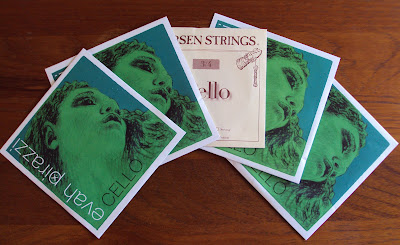Jargar strings have remained pretty much unchanged since my childhood --even the packaging -- so it was a welcome surprise that recently, they came out with a better-grade string, the "Superior".
About the "Superior": As far as I am aware, the "Superior" Jargar brand is limited, so far, to the A string. It is priced to compete with the Larsen Soloist A, and is a higher-tension string than the regular Jargar.
Fit&Finish: In keeping with their general air of mystique, Jargar doesn't really tell us anything much about what their strings are made of, unlike other companies who supply comparative charts and graphs with string lengths, gauges, weights, materials ... I tried the "Superior" on a cello I was setting up this week. As is often the case, when you add a better A string (or, in the case of a violin, E string), it "lifts" the sonority of the entire instrument -- the improved range of overtones bolsters overall sound. I didn't feel the sound had quite the lustrous quality you can achieve with a Larsen string, but that might have been a function of the particular instrument, too -- I will revisit the issue and do more comparative study.
Price: At House of Note, where I work, the Jargar "Superior" retails for $78.00, while the regular Jargar A is priced at $51.00. The Larsen Soloist and regular go for $78.75 and $68.00, respectively.
Conclusion: If you like the warm and velvety sound of Jargars, but have been yearning for more projection, the "Superior" definitely represents a vast improvement over the regular Jargar A -- I personally applaud Jargar for branching out, after all these years, and trying something new!

























